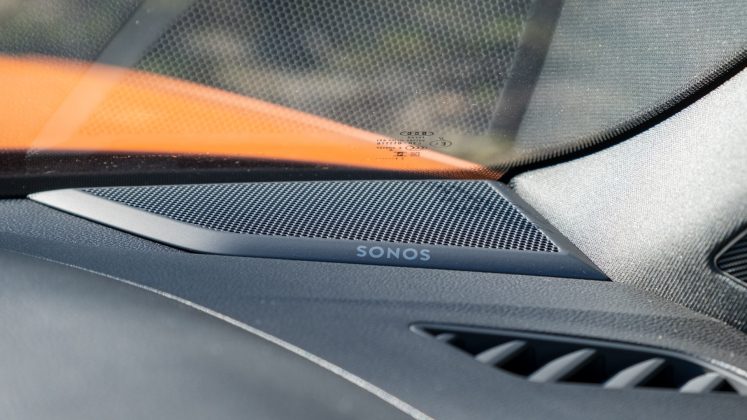The Audi Q3 is a stylish, practical and comfortable SUV that’s also available as a plug-in hybrid (TFSI e). We found it to be a competent all-rounder but provided lacklustre efficiency and performance over rival alternatives.
When it comes to audio, the Q3 houses six speakers as standard, but can be upgraded to a 15-speaker Sonos configuration if you elect to choose the £1,395 Technology Pack. On review is the latter system.
Click here to read the full Audi Q3 TFSI e review
Audi Q3 audio setup
To tinker with the vehicle’s audio settings, you have to navigate to the appropriate Sound menu on the 10.1″ infotainment system. Here are our optimal settings:
- Treble: +3
- Bass: -1
- Subwoofer: +2
- Focus: All
- Surround level: -3
- 3D Sound: Low
- Balance & fader: Centre
In terms of connectivity, both Apple CarPlay and Android Auto are supported over a wired and wireless connection. Bluetooth is also available, with the Q3’s infotainment system supporting the SBC and AAC codecs. However, we’d always recommend plugging in your smartphone to get the utmost audio fidelity.
As for media controls, they can be accessed through the display, via the physical knob found below the screen or via the buttons located on the steering wheel.
Read next: BMW iX1 (BMW X1) audio review: Harman Kardon upgrade?
Audi Q3 audio performance
For a demo of the Audi Q3’s audio system head on over to our YouTube channel.
When it comes to its audio configuration, the six-speaker system houses a speaker within each of the four doors and tweeters within the A-pillars. The 15-speaker Sonos system is a lot more complex. At each extremity of the dashboard, you’ll find a midrange driver, while at the centre, there are a further two speakers. Each of the A-pillars has a tweeter too. The front doors each house a singular woofer. The rear doors, however, are fitted with a woofer and a tweeter each. A midrange driver can be found in each of the C-pillars. To complete the system, there’s a subwoofer located in the underfloor compartment within the boot.
Given the addition of a subwoofer, the Sonos system provides some grunt in the low-end tones. There’s a decent level of rumble, which can be heard in bass-orientated tracks, adding good dynamism to the system. However, the boot-mounted subwoofer fails to deliver that pronounced low-end extension. It can’t quite compete with some of its rivals, which offer a more pronounced sub-bass experience.
On the other hand, the mid-bass impact of the Sonos system is near-perfect. The bass hits in The Weeknd ft. Daft Punk ‘I Feel It Coming’ are both controlled and have the right amount of quantity. The former is an objective observation, while the latter is purely subjective. You can adjust the bass impact via the infotainment system.
Buy a car phone mount on Amazon (Affiliate)
What you can’t do, however, is independently adjust the mid-range from the highs. A so-called feature we’ve noted in other vehicles from the Volkswagen Group, including Audi. It’s rather disappointing that these sound frequencies have been lobbed into the same category, meaning that any adjustment made to the ‘Treble’ EQ not only affects the mids but also the highs. As such, adding three notches was our limit, as it becomes ear-fatiguing at the top end.
With said EQ, the mid-range is still pushed back and recessed. Somewhat surprising as Sonos is known for having forward-sounding mids in its consumer speakers and soundbars. Indeed, both male and female vocals fail to come to full fruition, which will leave you wanting more, especially when you consider other in-car audio systems out there provide superior performance.
Thankfully, the highs extend tremendously well both at the front and rear of the cabin. This is, in part, thanks to the dedicated tweeters that one can find within the dashboard and rear doors. You’ll have that zingy, toe-tapping feeling no matter where you’re sat.
As for the soundstage, it’s a double-edged sword. With ‘3D Sound’ set to ‘High’, there’s an odd reverb, which takes away from the overall accuracy. Disable said option and you’ll find that the system has a uni-directional output that leaves much to be desired. The middle ground is the ‘Low’ mode, which still retains a certain level of authenticity without sounding dull and boring. To help with vocal precision, we’d suggest taking a few notches off the ‘Surround Level’ setting.
Finally, onto cabin noise, the Q3 has a good level of insulation. Granted, you will hear the engine thrashing away on a kick-down and a bit of tyre noise creeping in at higher speeds, but in the grander scheme of things, it’s a serene environment. At a standstill, we recorded 35-36 dBA; driving at 20-30mph 54-58 dBA; driving at 40mph 61-64 dBA; and at 70mph 68-73 dBA.
Read next: Citroen C5 X audio review: Best soundproofing?
TotallyEV’s verdict on the Audi Q3’s audio system
On the whole, the Sonos system comprised within the Audi Q3 is a worthwhile consideration for those who love their music. It’s a notable upgrade over the stock six-speaker system, and considering the £1,395 Technology Pack also adds a few other goodies, it’s easy to recommend.
However, given the Q3’s asking price, and the lacklustre performance in the mid-range and sub-bass tones, the Sonos system fails to stand out over rival alternatives.
What do you make of the Sonos upgrade? Let us know in the comments section below or via social media; we’re on: YouTube, Instagram, Facebook, X and LinkedIn.

























